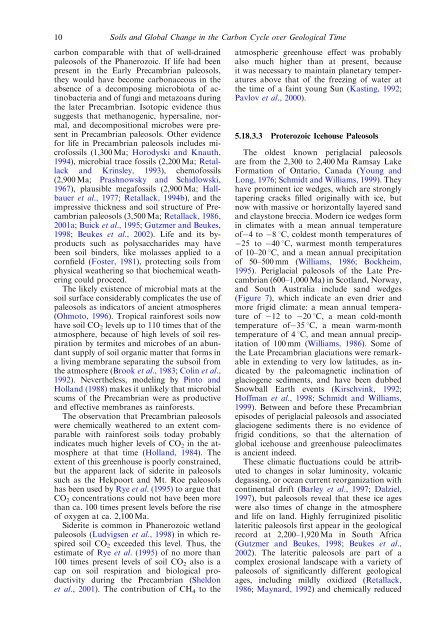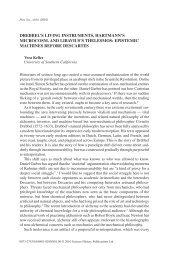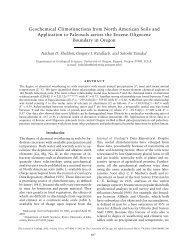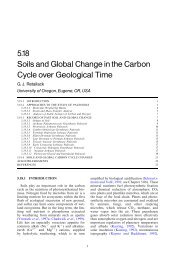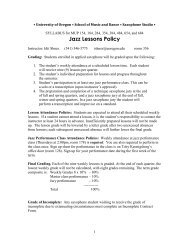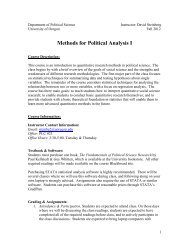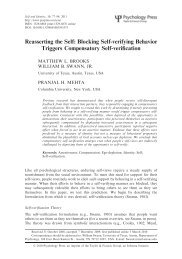Retallack 2007 Proserpina principle - University of Oregon
Retallack 2007 Proserpina principle - University of Oregon
Retallack 2007 Proserpina principle - University of Oregon
You also want an ePaper? Increase the reach of your titles
YUMPU automatically turns print PDFs into web optimized ePapers that Google loves.
10 Soils and Global Change in the Carbon Cycle over Geological Timecarbon comparable with that <strong>of</strong> well-drainedpaleosols <strong>of</strong> the Phanerozoic. If life had beenpresent in the Early Precambrian paleosols,they would have become carbonaceous in theabsence <strong>of</strong> a decomposing microbiota <strong>of</strong> actinobacteriaand <strong>of</strong> fungi and metazoans duringthe later Precambrian. Isotopic evidence thussuggests that methanogenic, hypersaline, normal,and decompositional microbes were presentin Precambrian paleosols. Other evidencefor life in Precambrian paleosols includes micr<strong>of</strong>ossils(1,300 Ma; Horodyski and Knauth,1994), microbial trace fossils (2,200 Ma; <strong>Retallack</strong>and Krinsley, 1993), chem<strong>of</strong>ossils(2,900 Ma; Prashnowsky and Schidlowski,1967), plausible megafossils (2,900 Ma; Hallbaueret al., 1977; <strong>Retallack</strong>, 1994b), and theimpressive thickness and soil structure <strong>of</strong> Precambrianpaleosols (3,500 Ma; <strong>Retallack</strong>, 1986,2001a; Buick et al., 1995; Gutzmer and Beukes,1998; Beukes et al., 2002). Life and its byproductssuch as polysaccharides may havebeen soil binders, like molasses applied to acornfield (Foster, 1981), protecting soils fromphysical weathering so that biochemical weatheringcould proceed.The likely existence <strong>of</strong> microbial mats at thesoil surface considerably complicates the use <strong>of</strong>paleosols as indicators <strong>of</strong> ancient atmospheres(Ohmoto, 1996). Tropical rainforest soils nowhave soil CO 2 levels up to 110 times that <strong>of</strong> theatmosphere, because <strong>of</strong> high levels <strong>of</strong> soil respirationby termites and microbes <strong>of</strong> an abundantsupply <strong>of</strong> soil organic matter that forms ina living membrane separating the subsoil fromthe atmosphere (Brook et al., 1983; Colin et al.,1992). Nevertheless, modeling by Pinto andHolland (1988) makes it unlikely that microbialscums <strong>of</strong> the Precambrian were as productiveand effective membranes as rainforests.The observation that Precambrian paleosolswere chemically weathered to an extent comparablewith rainforest soils today probablyindicates much higher levels <strong>of</strong> CO 2 in the atmosphereat that time (Holland, 1984). Theextent <strong>of</strong> this greenhouse is poorly constrained,but the apparent lack <strong>of</strong> siderite in paleosolssuch as the Hekpoort and Mt. Roe paleosolshas been used by Rye et al. (1995) to argue thatCO 2 concentrations could not have been morethan ca. 100 times present levels before the rise<strong>of</strong> oxygen at ca. 2,100 Ma.Siderite is common in Phanerozoic wetlandpaleosols (Ludvigsen et al., 1998) in which respiredsoil CO 2 exceeded this level. Thus, theestimate <strong>of</strong> Rye et al. (1995) <strong>of</strong> no more than100 times present levels <strong>of</strong> soil CO 2 also is acap on soil respiration and biological productivityduring the Precambrian (Sheldonet al., 2001). The contribution <strong>of</strong> CH 4 to theatmospheric greenhouse effect was probablyalso much higher than at present, becauseit was necessary to maintain planetary temperaturesabove that <strong>of</strong> the freezing <strong>of</strong> water atthe time <strong>of</strong> a faint young Sun (Kasting, 1992;Pavlov et al., 2000).5.18.3.3 Proterozoic Icehouse PaleosolsThe oldest known periglacial paleosolsare from the 2,300 to 2,400 Ma Ramsay LakeFormation <strong>of</strong> Ontario, Canada (Young andLong, 1976; Schmidt and Williams, 1999). Theyhave prominent ice wedges, which are stronglytapering cracks filled originally with ice, butnow with massive or horizontally layered sandand claystone breccia. Modern ice wedges formin climates with a mean annual temperature<strong>of</strong> 4to 8 1C, coldest month temperatures <strong>of</strong>25 to 40 1C, warmest month temperatures<strong>of</strong> 10–20 1C, and a mean annual precipitation<strong>of</strong> 50–500 mm (Williams, 1986; Bockheim,1995). Periglacial paleosols <strong>of</strong> the Late Precambrian(600–1,000 Ma) in Scotland, Norway,and South Australia include sand wedges(Figure 7), which indicate an even drier andmore frigid climate: a mean annual temperature<strong>of</strong> 12 to 20 1C, a mean cold-monthtemperature <strong>of</strong> 35 1C, a mean warm-monthtemperature <strong>of</strong> 4 1C, and mean annual precipitation<strong>of</strong> 100 mm (Williams, 1986). Some <strong>of</strong>the Late Precambrian glaciations were remarkablein extending to very low latitudes, as indicatedby the paleomagnetic inclination <strong>of</strong>glaciogene sediments, and have been dubbedSnowball Earth events (Kirschvink, 1992;H<strong>of</strong>fman et al., 1998; Schmidt and Williams,1999). Between and before these Precambrianepisodes <strong>of</strong> periglacial paleosols and associatedglaciogene sediments there is no evidence <strong>of</strong>frigid conditions, so that the alternation <strong>of</strong>global icehouse and greenhouse paleoclimatesis ancient indeed.These climatic fluctuations could be attributedto changes in solar luminosity, volcanicdegassing, or ocean current reorganization withcontinental drift (Barley et al., 1997; Dalziel,1997), but paleosols reveal that these ice ageswere also times <strong>of</strong> change in the atmosphereand life on land. Highly ferruginized pisoliticlateritic paleosols first appear in the geologicalrecord at 2,200–1,920 Ma in South Africa(Gutzmer and Beukes, 1998; Beukes et al.,2002). The lateritic paleosols are part <strong>of</strong> acomplex erosional landscape with a variety <strong>of</strong>paleosols <strong>of</strong> significantly different geologicalages, including mildly oxidized (<strong>Retallack</strong>,1986; Maynard, 1992) and chemically reduced


